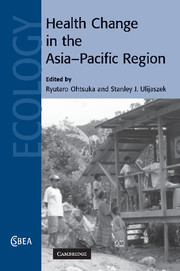Book contents
- Frontmatter
- Contents
- List of contributors
- Acknowledgements
- 1 Health change in the Asia-Pacific region: disparate end-points?
- 2 Interactions of nutrition, genetics and infectious disease in the Pacific: implications for prehistoric migrations
- 3 Biocultural adaptation and population connectedness in the Asia-Pacific region
- 4 Changing nutritional health in South East Asia
- 5 Obesity and nutritional health in Hong Kong Chinese people
- 6 Modernization, nutritional adaptability and health in Papua New Guinea Highlanders and Solomon Islanders
- 7 Tongan obesity: causes and consequences
- 8 Nutrition and health in modernizing Samoans: temporal trends and adaptive perspectives
- 9 Health patterns of Pacific Islanders and Asians in the United States
- 10 Impacts of modernization and transnationalism on nutritional health of Cook Islanders
- 11 Mortality decline in the Pacific: economic development and other explanations
- 12 Health changes in Papua New Guinea: from adaptation to double jeopardy?
- Index
- References
3 - Biocultural adaptation and population connectedness in the Asia-Pacific region
Published online by Cambridge University Press: 15 September 2009
- Frontmatter
- Contents
- List of contributors
- Acknowledgements
- 1 Health change in the Asia-Pacific region: disparate end-points?
- 2 Interactions of nutrition, genetics and infectious disease in the Pacific: implications for prehistoric migrations
- 3 Biocultural adaptation and population connectedness in the Asia-Pacific region
- 4 Changing nutritional health in South East Asia
- 5 Obesity and nutritional health in Hong Kong Chinese people
- 6 Modernization, nutritional adaptability and health in Papua New Guinea Highlanders and Solomon Islanders
- 7 Tongan obesity: causes and consequences
- 8 Nutrition and health in modernizing Samoans: temporal trends and adaptive perspectives
- 9 Health patterns of Pacific Islanders and Asians in the United States
- 10 Impacts of modernization and transnationalism on nutritional health of Cook Islanders
- 11 Mortality decline in the Pacific: economic development and other explanations
- 12 Health changes in Papua New Guinea: from adaptation to double jeopardy?
- Index
- References
Summary
Introduction
This chapter focuses on physiological adaptations of speakers of Non-Austronesian (NAN) and Austronesian (AN) languages in space and time, with some reference to Aboriginal Australian populations. The language-based dichotomous classification of Oceanian populations into the NAN and AN language groups has been, in general, in agreement with biological traits observed in either (Kirk and Szathmary 1985; Hill and Serjeantson 1989; Attenborough and Alpers 1992; Yoshida et al. 1995; Ohashi et al. 2000, 2003). In relation to colonization histories, the descendants of first-wave migrants belong to the NAN language group. Their ancestors reached Sahul Land from Asia, subsequently some of them dispersing into present-day Australia, becoming Aboriginal Australians. Second-wave migrants and their descendants, represented by Lapita people, were and continue to be AN speakers. The Lapita people dispersed later from their homeland in island Melanesia in Near Oceania (Green 1991) into Remote Oceania, or islands in South East Melanesia as well as Polynesia and Micronesia. The extent of admixture of NAN and AN language groups in island Melanesia and later in wider Melanesia remains debated, however. As demonstrated by several studies (Serjeantson et al. 1983; Friedlaender 1987), genetic traits and languages do not always correlate, due to replacement of languages and/or pidginization or creolization of the languages themselves; for similar reasons, links between Aboriginal Australian languages and NAN languages have scarcely been found (Foley 1986).
- Type
- Chapter
- Information
- Health Change in the Asia-Pacific Region , pp. 44 - 63Publisher: Cambridge University PressPrint publication year: 2007
References
- 1
- Cited by



